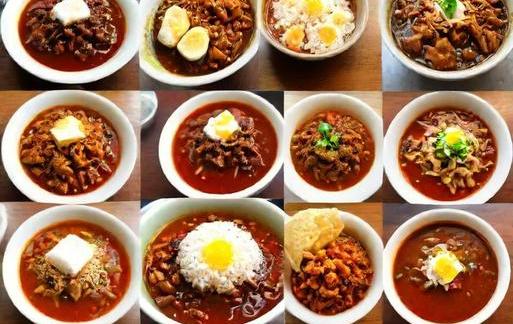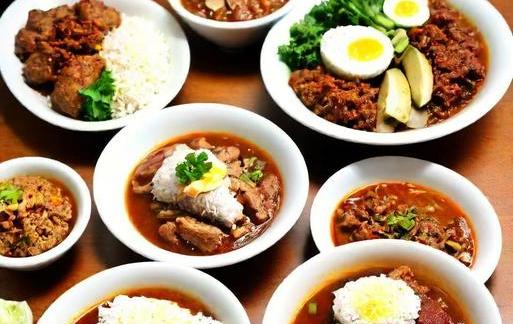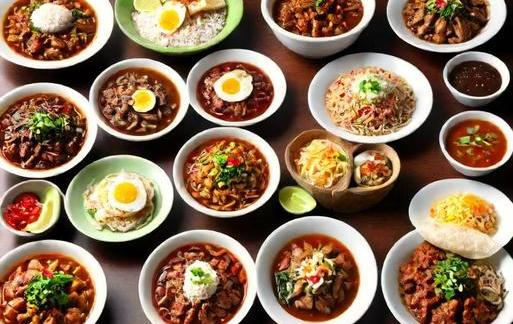- You are here:
- Home »
- Food
- » [REVEALED] Filipino Foods That Start With P
[REVEALED] Filipino Foods That Start With P
Note: This page contains affiliate links.
As an Amazon Associate, I earn from qualifying purchases when you click on the link, but you are not charged extra.
Filipino cuisine is a rich tapestry of flavors, influenced by centuries of cultural exchange and regional diversity. From savory stews to sweet desserts, Filipino dishes offer a wide array of culinary delights. In this article, we delve into the realm of Filipino foods that start with the letter "P." From traditional favorites to lesser-known delicacies, each dish offers a unique glimpse into the vibrant gastronomic landscape of the Philippines.
Contents
List Of Filipino Foods That Start With P

1. Pancit
Pancit is a staple in Filipino cuisine, encompassing a variety of noodle dishes typically stir-fried with vegetables, meat, and seafood. From the popular Pancit Canton to the flavorful Pancit Malabon, these dishes showcase the versatility of noodles in Filipino cooking. Each region of the Philippines boasts its own version of pancit, incorporating local ingredients and cooking techniques to create distinctive flavors.
2. Pinakbet
Pinakbet is a traditional Filipino vegetable dish hailing from the Ilocos region in the northern part of the Philippines. It features a medley of locally-grown vegetables such as bitter melon (ampalaya), eggplant, okra, squash, and string beans, simmered in shrimp paste (bagoong) for a savory umami flavor. Pinakbet is a nutritious and flavorful dish that highlights the abundance of fresh produce in Filipino cooking.
3. Paksiw
Paksiw refers to a cooking method in Filipino cuisine where meat or seafood is simmered in vinegar, garlic, and spices. One popular variation is Paksiw na Lechon, which uses leftover roasted pig (lechon) simmered in a tangy vinegar sauce until tender and flavorful. The acidity of the vinegar helps tenderize the meat while imparting a distinctive sour taste to the dish. Paksiw is often enjoyed as a comforting meal served with steamed rice.
4. Pork Adobo
Pork Adobo is arguably one of the most iconic Filipino dishes, characterized by its rich, tangy, and slightly sweet flavor profile. Pork belly or shoulder is marinated in a mixture of soy sauce, vinegar, garlic, bay leaves, and peppercorns, then simmered until tender. The slow cooking process allows the meat to absorb the bold flavors of the marinade, resulting in a savory and succulent dish. Pork Adobo is often served with steamed rice and enjoyed across the Philippines.
5. Pandesal
Pandesal is a classic Filipino bread roll that serves as a staple breakfast item or snack. Soft, fluffy, and slightly sweet, pandesal is made from a simple dough of flour, yeast, sugar, salt, and breadcrumbs. It is typically enjoyed fresh from the oven, either plain or filled with a variety of spreads such as butter, cheese, or jam. Pandesal is a beloved comfort food in the Philippines, enjoyed by people of all ages throughout the day.
6. Palitaw
Palitaw is a traditional Filipino rice cake that is popularly enjoyed as a snack or dessert. Made from glutinous rice flour, water, and sugar, the dough is shaped into small patties before being boiled and then coated with grated coconut and sesame seeds. The name "palitaw" comes from the Tagalog word "litaw," which means to float, referring to the cakes floating to the surface when cooked. Palitaw is known for its chewy texture and subtle sweetness, making it a delightful treat for special occasions or everyday indulgence.
7. Puto
Puto is a type of Filipino steamed rice cake that is enjoyed as a snack or accompaniment to savory dishes. Made from rice flour, sugar, and baking powder, the batter is poured into small molds and steamed until fluffy and cooked through. Puto comes in various colors and flavors, with popular variations including Puto Cheese, which features cheese as a topping, and Puto Bumbong, which is dyed purple and traditionally served during the Christmas season. Puto is a versatile and comforting Filipino delicacy enjoyed by people of all ages.
8. Pancit Palabok
Pancit Palabok is a Filipino noodle dish characterized by its vibrant orange hue and flavorful toppings. Thin rice noodles are smothered in a rich shrimp sauce made from ground shrimp, annatto seeds, and fish sauce, then topped with an array of garnishes such as boiled eggs, shrimp, pork cracklings (chicharron), and green onions. Pancit Palabok is a festive and indulgent dish often served during celebrations and special occasions, showcasing the diverse flavors and textures of Filipino cuisine.
9. Pan De Coco
Pan de Coco is a popular Filipino bread roll filled with sweetened coconut filling. The dough is made from flour, yeast, sugar, and milk, then filled with a mixture of grated coconut and brown sugar before being baked to golden perfection. The combination of soft bread and sweet coconut filling makes Pan de Coco a delightful treat enjoyed by many Filipinos as a snack or dessert.
10. Pastillas
Pastillas is a sweet confectionery made from condensed milk and sugar, molded into small cylindrical shapes and coated with granulated sugar. This melt-in-your-mouth treat is a favorite among Filipinos, especially during special occasions such as fiestas and holidays. Pastillas can also be flavored with different ingredients such as chocolate, ube (purple yam), and langka (jackfruit), adding variety to this beloved Filipino delicacy.
Filipino cuisine offers a diverse array of dishes that start with the letter "P," each showcasing the unique flavors, ingredients, and culinary techniques of the Philippines. From hearty stews to
Significance

The culinary landscape of the Philippines is a rich tapestry woven with diverse flavors, textures, and aromas. One fascinating aspect of Filipino cuisine is the plethora of dishes that start with the letter “P”. From savory to sweet, these dishes showcase the creativity and resourcefulness of Filipino cooks. In this comprehensive exploration, we will delve into the significance of these foods, categorize them, unravel common themes, and present some intriguing facts that add depth to our understanding of Filipino gastronomy.
The significance of Filipino foods that start with ‘P’ goes beyond mere gastronomy; it is a reflection of the cultural heritage and historical influences that have shaped the Filipino palate. Many of these dishes are rooted in traditional cooking methods, indigenous ingredients, and the fusion of various culinary influences, including Spanish, Chinese, and Malay. The use of ‘P’ in these food names may seem coincidental, but it adds a delightful linguistic rhythm to the culinary lexicon.
Category-Related

1. Pancit Canton
Pancit Canton, a stir-fried noodle dish, is a classic example of Filipino ingenuity in creating a dish that is not only flavorful but also visually appealing. The dish typically includes a medley of vegetables, meat (often chicken or pork), and a savory soy-based sauce. The noodles, stir-fried to perfection, absorb the flavors of the ingredients, resulting in a harmonious blend of textures and tastes.
2. Puto Bumbong
Puto Bumbong is a beloved Filipino delicacy, especially during the Christmas season. These purple rice cakes are steamed in bamboo tubes, giving them a distinctive shape and a unique flavor. Traditionally served with grated coconut and muscovado sugar, Puto Bumbong embodies the warmth and festivity of Filipino celebrations.
3. Paksiw Na Bangus
Paksiw na Bangus, or Milkfish Stew, is a savory and tangy dish that features milkfish cooked in vinegar, garlic, and ginger. This cooking method not only imparts a delightful sourness to the dish but also helps preserve the fish. The addition of various spices and vegetables enhances the overall flavor profile, making it a staple in Filipino households.
4. Pinakbet
Pinakbet is a vegetable dish that hails from the northern regions of the Philippines. This savory medley includes a variety of locally grown vegetables like eggplant, okra, squash, and bitter melon, all simmered in shrimp paste and flavored with garlic and ginger. The result is a colorful and nutritious dish that showcases the abundance of fresh produce in Filipino cuisine.
5. Pandesal
Pandesal, often referred to as the Filipino bread roll, is a staple in Filipino breakfasts. Soft and slightly sweet, Pandesal is enjoyed with a variety of fillings such as cheese, butter, or Filipino-style corned beef. Its versatility and widespread popularity make it an integral part of the Filipino dining experience.
Common Themes
While the ‘P’ in these Filipino foods may seem coincidental, there are common themes that tie these dishes together, creating a cohesive culinary narrative.
1. Preservation Techniques
Several ‘P’ dishes, such as Paksiw na Bangus, utilize preservation techniques like vinegar or fermentation. These methods not only enhance flavor but also contribute to the longevity of the dish, allowing for practical storage in a tropical climate where the preservation of food is crucial.
2. Celebratory Dishes
Many of these dishes, like Puto Bumbong, hold special significance during festive occasions. The ‘P’ dishes often find their way to the center of the dining table during celebrations, symbolizing the communal joy and shared traditions that define Filipino culture.
3. Influence Of Indigenous Ingredients
The use of indigenous ingredients is a common thread in Filipino cuisine, and the ‘P’ dishes are no exception. Whether it’s the purple rice in Puto Bumbong or the local vegetables in Pinakbet, these dishes celebrate the abundance of natural resources found in the Philippines.
Interesting Facts
1. Puto Bumbong’s Unique Cooking Process
The cooking process of Puto Bumbong is as fascinating as its taste. The purple glutinous rice mixture is placed inside bamboo tubes called "bumbong" and then steamed. The result is a delectable treat with a slightly chewy texture and a distinct purple hue, thanks to the rice variety used.
2. Pancit Canton’s Chinese Influence
While Pancit Canton is undeniably a Filipino favorite, its origins can be traced back to Chinese cuisine. The stir-frying technique and the use of noodles are reminiscent of Chinese cooking methods, highlighting the historical and cultural exchange that has shaped Filipino culinary traditions.
3. Puto Bumbong’s Christmas Connection
Puto Bumbong is strongly associated with the Christmas season in the Philippines. It is a common sight during Simbang Gabi, a series of dawn masses leading up to Christmas Day. The warm aroma of Puto Bumbong wafting through the air adds to the festive atmosphere, making it a holiday must-have.
4. Pandesal’s Historical Roots
The history of Pandesal dates back to the Spanish colonial period. Introduced by Spanish bakers, Pandesal has evolved over the centuries to become a staple in Filipino households. Its name, which translates to "salt bread" in Spanish, reflects its initial ingredients, although the modern version often includes sugar for a slightly sweet taste.
Conclusion
In conclusion, the diverse array of Filipino foods that start with ‘P’ is a testament to the culinary richness and cultural diversity of the Philippines. From savory to sweet, these dishes showcase the creativity, resourcefulness, and adaptability of Filipino cooks throughout history. Whether enjoyed during celebrations or as daily fare, these ‘P’ dishes contribute to the unique tapestry of Filipino gastronomy, inviting locals and visitors alike to savor the flavors of this vibrant culinary tradition.


